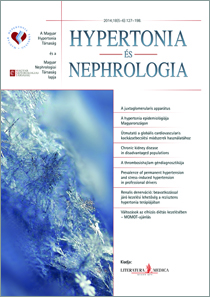The eLitMed.hu medical portal uses computer cookies for convenient operation. Detailed information can be found in the Cookie-policy.
Hypertension and nephrology - 2014;18(05-06)
Content
[Epidemiology of hypertension in Hungary]
[The most important aspects of Hungarian hypertension epidemiology are demonstrated. The prevalence of hypertension is continuously increasing and in 2011 from the nearly 10 million population exceeded 3 million. Its occurrence rises in parallel with the increase in of systolic blood pressure and the progression of age, and exceeds 60% in those aged over 65 years. The average blood pressure is increasing in children and adolescents, and isolated systolic hypertension is often observed in those over 65-70 years. The situation is closely related to overweight in the young, while in elderly the atherosclerotic process results in low diastolic blood pressure. The prevalence is significantly different in some regions with the highest incidence in South-Transdanubia and North- Hungary. Overall, there is a higher incidence in women. Among known hypertensive patients, the ratio of men is greater till 40-45 years; thereafter, there will be an equilibration and in elderly women the incidence will be higher. It is interesting, that the morbidity and mortality have significantly increased in hypertension and diabetes since 2004, while the incidence of myocardial infarction and stroke has significantly decreased. As concerns organ damage, an increase in occurrence of left ventricular hypertrophy and microalbuminuria has been observed. Metabolic syndrome, diabetes mellitus and ischemic heart disease were the most frequent comorbidities.]
[Guide for using methods of cardiovascular risk estimation]
[Author analyzes the most frequently used, reliable cardiovascular risk estimation methods. Only those methods are useful that meet to the american and european prevention guidelines and were edited by processing of the great databases. The best known risk estimation methods are continuously is expanding by growing body of knowledge and by another iseful risk factors, because the only way in order to successfully prevent the cardiovascular diseases. Two types of method-groups are known: 1. Traditional narrowed form for the general practisers and for the large section of population, 2. Methods with a broader analysis and more risk factors for the specialists and scientists. In Europe PROCAM and Heart Score and their variations are most useful for the practical medical work, but it is possible to use the american ASCVD and Reynolds risk estimation methods as well using the help of the national correction factors. The methods with wider analysis and much more risk factors as the Mayo Clinic mode, Qrisk2 and IHMRS are suitable in assisting of the epidemiologic studies or scientific work.]
[Genetic diagnostics of the trombosis risk]
[The cardiovascular system and the coalugation process play essential role in regulating the homestasis of the human body. Thrombuses may appear in veins (venous thrombosis) as well as arteries (arterial thrombosis) that may cause a wide range of ischemic vascular diseases. By mapping genetic risk factors that may accelarate the development of thrombosis, the quality of medical preventions and therapies can be improved. The most frequent gene mutations (FII, FV, PAI-1, MTHFR and EPCR gene polimorphisms) can be tested by methods based on PCR, real-time PCR and macroarray techniques. Professionals may use genetic results for selecting appropriate and optimal therapies based on the context of a patient’s medical history.]
[Changing dietary guidelines in obesity. MOMOT recommendation]
[In the 70s and 80s due to the heart attack „epidemic” the low fat diet was encouraged based on the cholesterol theory, with moderate success. At the same time, the consumption of carbohydrates increased with the frequency of obesity rising from 1971 to 30% in the USA. Foods with high glicemic index and rich in carbohydrates result in a fast increase in glucose level, insuline actions also leading to glucose – fatty acid transformation and weight gain. Over the last decades several comparative trials have proven that with the low carb diet one can lose about 3- more than with the low fat diet in half a year. The excessive low carbohydrate Atkins diet over 1 year (), was superior even to ZONE (), LEARN (), ORNISH () diet, in another trial, over two years also the „low fat” diet. International Association for the Study of Obesity (IASO) recommends an increased protein intake (15 → 25%) along with carbohydrate with low glicemic index (GI). According to the summarized guidelines of the Hungarian Society of Obesitology and Excercise Therapy (MOMOT) low calorie (1200-1500 kcal / day), low-carb (<45%) – low-GI, high-protein (≥ 25%), low-fat (38→30%) diet is recommended, by witch a weight loss of 10 kg/half year can be expected. After half a year patient compliance deteriorates and they can hardly keep even the low-carb diet, whose significant advantage diminishes by this. We hope that patient compliance can be helped with two new appetite decreasing drugs, namely lorcaserin and a combination of phentermin and topiramat. Future dietary recommendations may be influenced by the new guideline issued in November 2013 by AHA/ACC, and the Obesity Society the final approval of which by NHLBI can be expected by June 2014.]
1.
Clinical Neuroscience
[Headache registry in Szeged: Experiences regarding to migraine patients]2.
Clinical Neuroscience
[The new target population of stroke awareness campaign: Kindergarten students ]3.
Clinical Neuroscience
Is there any difference in mortality rates of atrial fibrillation detected before or after ischemic stroke?4.
Clinical Neuroscience
Factors influencing the level of stigma in Parkinson’s disease in western Turkey5.
Clinical Neuroscience
[The effects of demographic and clinical factors on the severity of poststroke aphasia]1.
2.
3.
4.
5.



